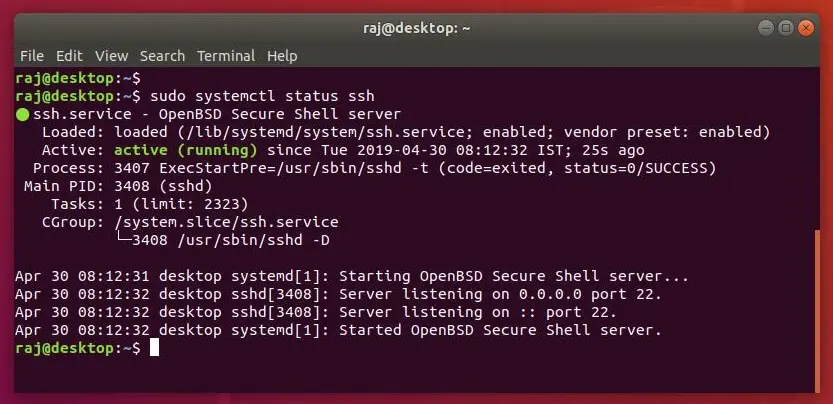You must have server root login details to restart SSH service. The server login details will be provided by your webhosting company/Datacenter. You can log into the server using putty software. Putty software can be downloaded from the website putty.org and you can connect to your server via SSH. Use systemctl command instead of ‘service’ command to restart service on CentOS 7 and RHEL 7 servers. RHEL 7 and CentOS 7 migrated to Systemd and commands like ‘service’ and ‘chkconfig’ is now done using ‘systemctl’.
- Restart Service Sshd Mac
- Dss 5027 Codes
- Restart Sshd Service Ubuntu
- Ubuntu Restart Sshd Service
- Linux Restart Sshd Service
Example:
You should not 'need' to run your application as user 'daemon' or 'systemd'. Instead, run your app as the user it was designed for. If running 'as' daemon/systemd seemed to solve your problem, you merely found an incorrect workaround (and the true problem probably relates to permissions, see 'ExecStartPre=' if I were to take a guess at your root issue) – Scott Prive Jul 1 '20 at 15:02. Sudo systemctl restart ssh sudo service ssh restart The service is also controlled by upstart, and not sysvinit. So you'll find it at /etc/init/ssh.conf instead of /etc/init.d/ssh. If you want to change some settings (e.g., the listening port, and root login permission) by editing the configuration file via command. You can either use the command “service sshd restart” OR “/etc/init.d/sshd restart” to restart SSH service. There is no need to run both commands. root@server # service sshd restart Stopping sshd:. In this article. Linux virtual machines (VMs) in Azure are usually managed from the command line using a secure shell (SSH) connection. When new to Linux, or for quick troubleshooting scenarios, the use of remote desktop may be easier.
Redirecting to /bin/systemctl restart sshd.service
“/etc/init.d/sshd restart” command will not work on centOS 7 servers. You will see the below error if you try to restart using that command.
-bash: /etc/init.d/sshd: No such file or directory
HOW TO RESTART SSH SERVICE ON CENTOS 7 / RHEL 7 server
Do the below steps to restart SSH service on CentOS 7 / Redhat 7 Servers.
1. Log into your Linux Server via SSH as ‘root’ user
2. Run the command ‘systemctl restart sshd.service’ to restart SSH
Command 1 : service sshd restart
OR
Command 2 : systemctl restart sshd.service
root@server [~]# service sshd restartRedirecting to /bin/systemctl restart sshd.service
root@server [~]# systemctl restart sshd.service
root@server [~]#
HOW TO CHECK STATUS OF SSH SERVICE ON CentOS 7 / RHEL 7 server
The below commands can be used to check the current status of SSH service, it will show whether the service is active or inactive.1. Log into your Linux server as ‘root’
2. Run the Command ‘systemctl status sshd.service’ to check status of SSH service.
Command 1 : service sshd status
OR
Command 2 : systemctl status sshd.service
root@server [~]# systemctl status sshd.service* sshd.service – OpenSSH server daemon
Loaded: loaded (/usr/lib/systemd/system/sshd.service; enabled; vendor preset: enabled)
Active: active (running) since Sun 2016-04-24 20:14:10 EDT; 1min 10s ago
Docs: man:sshd(8)
man:sshd_config(5)
Main PID: 2881 (sshd)
CGroup: /system.slice/sshd.service


`-2881 /usr/sbin/sshd -D
Apr 24 20:14:10 server systemd[1]: Started OpenSSH server daemon.
Apr 24 20:14:10 server systemd[1]: Starting OpenSSH server daemon…
Apr 24 20:14:10 server sshd[2881]: Server listening on 0.0.0.0 port 22.
Apr 24 20:14:10 server sshd[2881]: Server listening on :: port 22.
Restart Service Sshd Mac
Active: active (running) —> If the status is “active (running)”, it means SSH service is running fine on this server
HOW TO START SSH SERVICE ON CENTOS 7 / REDHAT 7 SERVERS
Dss 5027 Codes
Run the below command to start SSH service (if the service is not running)1. Log into Linux server as root user
2. Run the below command to start SSH service
Command 1 : systemctl start sshd.service
OR
Command 2 : service sshd start
HOW TO STOP SSH SERVICE ON CENTOS 7 / REDHAT 7 SERVERS
Run the command ‘systemctl stop sshd.service’ to restart SSH service.
NOTE : The below commands will stop sshd service on your server and you might get disconnected from SSH. Run this command only if you have console access so that you can start the service.
Command 1 : service sshd stop
OR
Command 2 : systemctl stop sshd.service
root@server [/]# systemctl stop sshd.serviceOR

root@server [/]# service sshd stop
Redirecting to /bin/systemctl stop sshd.service
root 221572 0.0 0.0 64348 1180 ? Ss Jan26 0:55 /usr/sbin/ssh
Command to kill the above SSH process : kill -9 221572
chkconfig commands will not work on centOS 7 servers so you must use the below commands to enable and disable the SSH service in the runlevel.Restart Sshd Service Ubuntu

Enable SSH service : systemctl enable sshd
Disable SSH service : systemctl disable sshd
Ubuntu Restart Sshd Service
Run the below commands to check whether SSH service is enabled and active
[root@server ~]# systemctl is-failed sshd.serviceLinux Restart Sshd Service
active
[root@server ~]# systemctl is-active sshd.service
active
[root@server ~]# systemctl is-enabled sshd.service
enabled
